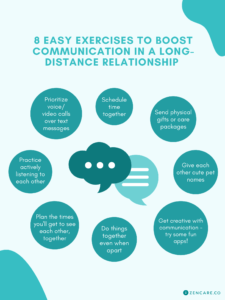Long Distance Relationship Neither Can Move
When in a long-distance relationship where neither can move, communication, trust, and commitment are crucial. Maintaining a strong emotional connection and planning visits together can help sustain the relationship.
Long-distance relationships can be challenging, especially when neither partner can relocate. It requires effective communication, trust, and a strong commitment to make the relationship work. We will discuss strategies for maintaining a healthy long-distance relationship, including the importance of emotional connection, planning visits, and prioritizing quality time together.
We will also explore ways to manage the challenges of distance and remain connected as a couple. If you’re navigating a long-distance relationship with no possibility of either partner moving, this guide is for you.

Understanding The Challenges
Navigating a long-distance relationship poses unique challenges, especially when neither partner can relocate. Balancing time zones, communication needs, and longing for physical closeness requires patience, trust, and creativity. Finding ways to maintain connection and understanding each other’s constraints becomes crucial in this situation.
Understanding the Challenges Long-distance relationships present many unique challenges that can have a significant impact on both partners. From the financial constraints to the emotional toll and communication barriers, navigating these challenges requires understanding, patience, and a strong commitment from both parties. Financial Constraints Maintaining a long-distance relationship can place a significant strain on finances. The cost of traveling to visit each other, long-distance calls, and even sending gifts can quickly add up. This can be particularly challenging for couples facing other financial commitments, such as student loans or living expenses. Emotional Toll Being physically separated from your partner can take a heavy emotional toll. The absence of physical touch and presence can lead to feelings of loneliness, anxiety, and even jealousy. Over time, this emotional strain can affect both partners’ mental well-being and create tensions in the relationship. Communication Barriers Distance can create communication barriers that are difficult to overcome. Time zone differences, busy work schedules, and limited opportunities for face-to-face interaction can make it challenging to maintain open and meaningful communication. Misunderstandings may arise more easily, leading to conflicts and frustrations. In conclusion, understanding the challenges of a long-distance relationship is crucial for maintaining a healthy and thriving partnership. By acknowledging and addressing these hurdles, couples can work together to overcome the obstacles and build a stronger, more resilient bond. This HTML code should be used for WordPress: “`htmlFinancial Constraints
Emotional Toll
Communication Barriers
Strategies For Maintaining Connection
Introductory paragraphLong-distance relationships can be challenging, especially when neither partner can relocate. But with the right strategies, maintaining connection and intimacy is achievable. Here are some effective tactics for navigating a long-distance relationship when neither partner can move:
H3 heading: Prioritizing regular communicationPrioritizing Regular Communication
Content for prioritizing regular communicationRegular communication is crucial in a long-distance relationship. Setting aside dedicated time for video calls, texts, and phone calls can help maintain a sense of closeness. It’s important to establish open and honest communication to address any concerns or feelings of distance that may arise.
H3 heading: Utilizing technology for virtual datesUtilizing Technology For Virtual Dates
Content for utilizing technology for virtual datesEmbracing virtual dates can help recreate the experience of spending time together in person. Using platforms like Skype, Zoom, or virtual reality technology can make date nights feel more immersive and personal. Planning activities such as watching a movie simultaneously or cooking the same recipe together can enhance the feeling of togetherness.
H3 heading: Planning visits and vacationsPlanning Visits And Vacations
Content for planning visits and vacationsVisits and vacations provide opportunities for in-person connection. Scheduling regular visits and planning vacations together can give both partners something to look forward to and create shared memories. When neither partner can relocate, having planned visits on the calendar can serve as a source of hope and anticipation.
Nurturing Trust And Security
Long-distance relationships can present unique challenges, particularly when neither partner can move. Trust and security are crucial elements for maintaining a healthy and strong bond in such circumstances. It’s essential for both individuals to proactively work on building and nurturing these aspects of their relationship.
Building Trust Through Transparency
Transparency is key in long-distance relationships where neither party can relocate. Open and honest communication about feelings, plans, and concerns can help in building mutual trust. Sharing daily experiences and discussing future goals and aspirations can help establish a strong foundation of trust and emotional intimacy.
Managing Jealousy And Insecurity
Jealousy and insecurity are common in long-distance relationships, and it’s crucial to address these emotions head-on. Healthy discussions about the root causes of such feelings and implementing strategies to overcome them can significantly strengthen the relationship. Encouraging trust and reassurance, alongside cultivating individual self-confidence, can help in managing jealousy and insecurity.
Establishing Mutual Support Systems
Establishing mutual support systems is vital for both partners, creating a strong and reliable network outside of the relationship. This support can include friends, family, or even online communities, serving as a source of comfort and guidance when faced with challenges. Knowing that both individuals have a robust support system can enhance feelings of security and stability.
Coping With Physical Separation
Dealing with the physical separation in a long-distance relationship can be challenging, but with the right mindset and strategies, it is possible to cope and thrive despite the distance. Whether it’s due to career commitments, educational pursuits, or other circumstances that prevent either partner from relocating, learning how to handle the physical separation is crucial for maintaining a healthy and fulfilling relationship.
Developing Personal Hobbies And Interests
Engaging in personal hobbies and interests can be a great way to fill the void of physical presence in a long-distance relationship. It allows individuals to focus on activities they enjoy and are passionate about, fostering personal growth and fulfillment. Whether it’s painting, playing a musical instrument, or exploring new outdoor activities, developing hobbies can provide a sense of purpose and enjoyment. This not only helps individuals to maintain a positive outlook during the separation but also offers opportunities to share these experiences with their partner, fostering a deeper connection.
Cultivating Independence And Self-care
Cultivating independence and prioritizing self-care during a long-distance relationship is essential for maintaining a balanced and healthy lifestyle. This involves taking time for self-reflection, practicing self-love, and setting boundaries to prevent feelings of loneliness or dependency. Embracing independence not only allows individuals to nurture their personal identity but also contributes to a stronger sense of confidence and resilience. Engaging in self-care practices such as regular exercise, meditation, and setting aside time for relaxation can have a positive impact on mental and emotional well-being, aiding in coping with the physical separation.
Managing Intimacy And Physical Needs
Navigating the challenges of maintaining intimacy and fulfilling physical needs in a long-distance relationship requires open and honest communication as well as creativity. Exploring ways to stay connected through video calls, handwritten letters, and surprise gifts can help bridge the physical gap. Additionally, prioritizing physical intimacy during in-person visits can strengthen the bond and create lasting memories. Engaging in open discussions about intimacy and finding ways to express affection from a distance are essential to ensure that both partners feel valued and connected despite the physical separation.
Decision-making And Planning For The Future
Long-distance relationships present unique challenges, particularly when neither partner can move due to various personal or professional reasons. Making decisions and planning for the future in such situations requires open communication, mutual understanding, and a shared vision for the relationship. This article delves into the crucial aspects of discussing long-term goals and plans, exploring potential solutions for relocation, and envisioning the future together.
Discussing Long-term Goals And Plans
When neither partner can move due to specific circumstances, it becomes essential to have open and honest conversations about long-term goals and plans. This involves considering factors such as career aspirations, family commitments, and personal aspirations. Setting clear goals and envisioning a shared future is crucial for maintaining the strength and sustainability of the relationship.
Exploring Potential Solutions For Relocation
In some cases, exploring potential solutions for relocation becomes necessary to bridge the gap in a long-distance relationship where neither partner can move. This may involve researching job opportunities, considering distance learning programs for further education, or evaluating the possibility of a temporary or permanent move for one of the partners. It requires a comprehensive approach that balances individual aspirations with the needs of the relationship.
Envisioning The Future Together
Envisioning the future together entails a collaborative effort to align both partners’ visions and aspirations. This involves strategic planning, compromise, and a willingness to adapt to changing circumstances. Visualizing a shared future creates a sense of purpose and solidarity, strengthening the foundation of the relationship and providing clarity on the path forward.
Frequently Asked Questions Of Long Distance Relationship Neither Can Move
How To Nurture A Long Distance Relationship?
Long distance relationships thrive on open communication, trust, and regular visits.
What Are The Benefits Of A Long Distance Relationship?
Challenges strengthen the bond, allowing for personal growth and independence.
Why Is Trust Crucial In A Long Distance Relationship?
Trust forms the foundation, solidifying the partnership despite physical distance.
How To Maintain Intimacy In A Long Distance Relationship?
Regular video calls, thoughtful gestures, and shared experiences help maintain closeness.
What Are The Common Challenges In Long Distance Relationships?
Time zone differences, loneliness, and communication barriers are common challenges.
How Can Long Distance Relationships Be Sustainable?
Open communication, future plans, and trust are essential for a sustainable long distance relationship.
Conclusion
Maintaining a long distance relationship can be challenging, but with effort and communication, it’s possible to make it work. From prioritizing quality time together to establishing trust, these relationships require understanding and commitment. By staying positive and embracing the distance as a temporary hurdle, you can build a strong and enduring connection with your partner.





